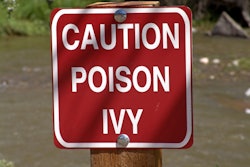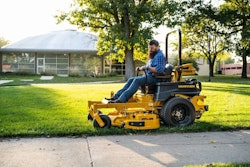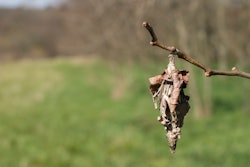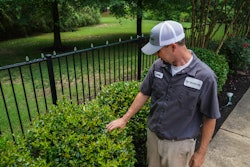
While mulching with virgin hardwood mulch can have benefits for plant beds in terms of moisture retention, and insulating fragile plant roots, the shift away from using quality products is having a negative impact on plant material. In fact, these days, mulch is often made from composted green waste and processed wood mulch—which doesn’t have the natural decomposition benefits offered by hardwood mulches.
On top of that, it’s not uncommon for many landscape contracts to call for routine applications of two inches or more of mulch—disregarding the current amount already present, says Chuck Whealton, region manager for Ruppert Landscape.
This can lead to an excessive amount of mulch piling up, which can cause more harm than good.
As this problem becomes increasingly prevalent, the Laytonsville, Maryland-based company has begun offering de-mulching services to clients. Though it sounds counterintuitive, it’s been instrumental in restoring the health of some unhealthy landscapes.
De-mulching is the process of exposing the tree’s root flare by removing excess mulch, decomposed mulch, and soil from the tree saucer down to the root flare, Whealton explains.
“This is important because over-mulch suffocates the plant,” Whealton continues. “Root flare burial inhibits gas exchange and kills phloem cells, interfering with the downward movement of food to the root system, leading to root dieback, reduced water uptake, and eventually the early death of the tree. A tree’s vascular system is comprised of two types of tissue that transport food/energy, nutrients, and water. The xylem transports nutrients and water from roots to shoots, while the phloem transports food sugars from the shoots to the roots. In human terms, think of the xylem and phloem as the plant’s veins and arteries.”
Fixing an over-mulching problem
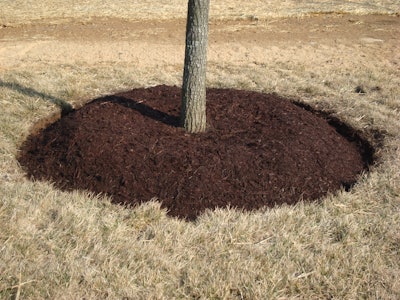 This example from Ruppert Landscape shows a properly mulched tree ring.Ruppert Landscape
This example from Ruppert Landscape shows a properly mulched tree ring.Ruppert Landscape
The process of over-mulching trees is often referred to as creating a “mulch volcano.” Unfortunately, this mistake is made even among landscape pros. If you’ve inherited a property with mulch volcanoes, it’s important to understand how to remedy the issue.
Whealton says that the obvious sign of buried root flares is not being able to visually locate it. But sometimes you or your clients may notice symptoms of an over-mulched tree ahead of anything else.
“The first evidence that a buried root flare is negatively impacting tree health is a yellowing of the foliage and early leaf coloration and drop,” Whealton says. “Over time, symptoms include stunted leaf size, reduced rate of growth, and dieback in the upper crown. This weakened state predisposes the tree to disease and a variety of other environmental factors.”
Whealton adds that shallow-rooted trees like maples, dogwoods, birch, ash, pin oak, spruce, and Eastern white pine are most susceptible to damage from root flare burial.
Proper de-mulching
In terms of de-mulching, Whealton says this service should be performed on all trees that have a buried root flare. Trees in beds are not exempt from this.
“This process is likely to be needed as a function of routine maintenance every five to seven years on average, assuming fresh mulching annually for aesthetics is a customer expectation and requirement,” he adds. “If addressed in time, declining trees will recover. But based on the severity of the decline, trees may need monitoring and supplemental care.”

